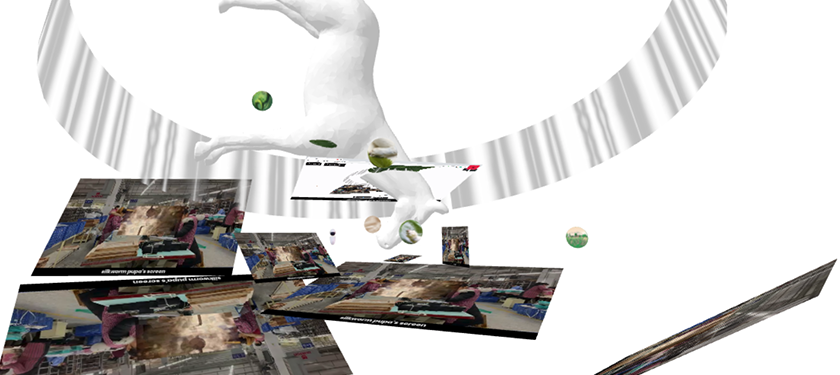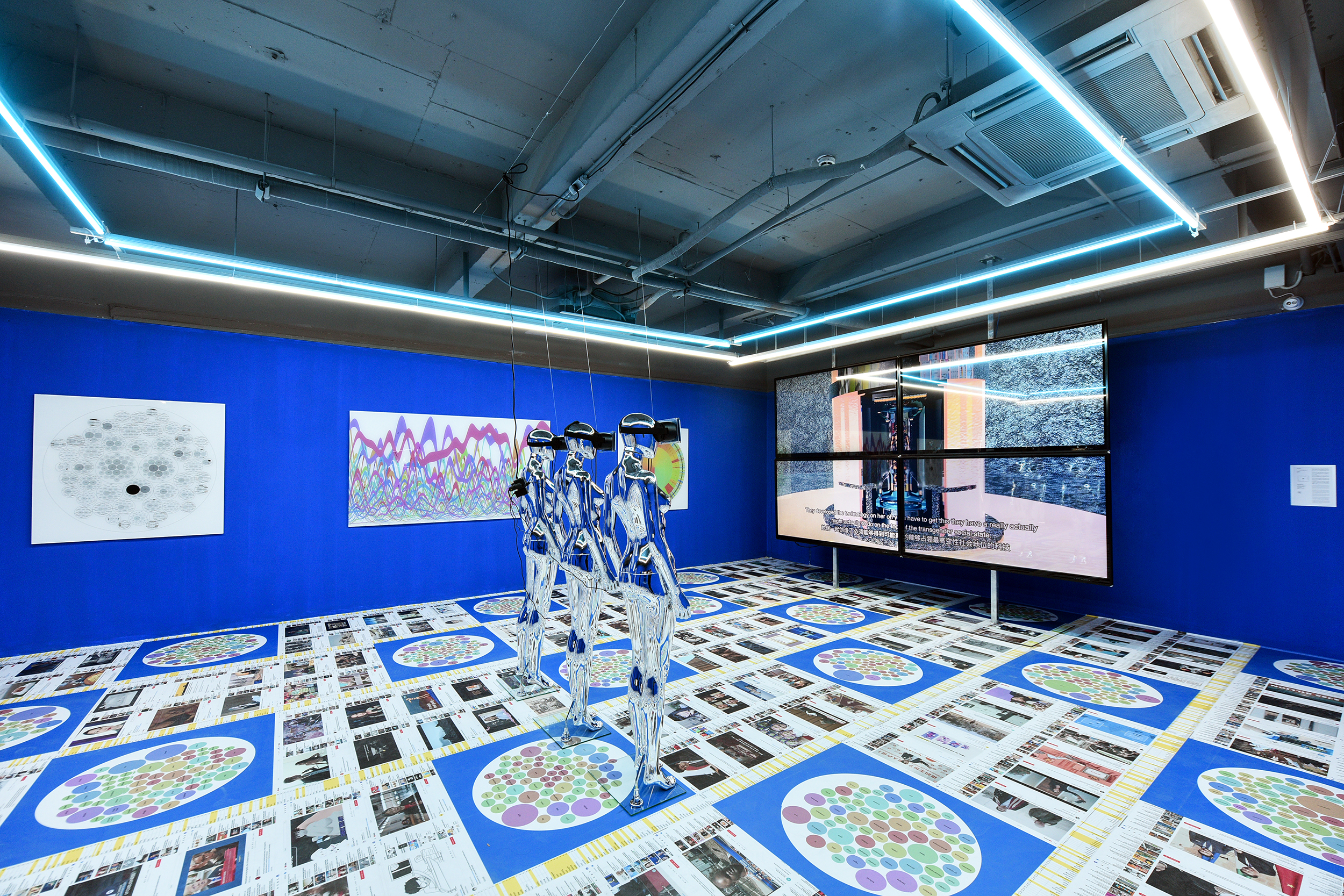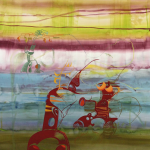Conversations | Jiaoyang Li and Ziyang Wu On Video Game Art
“Dare to try and collaborate with artist friends who work in other mediums and hopefully there will be some surprising outcomes.” — Jiaoyang Li
Jiaoyang Li (IAP ’20) is a multimedia artist whose work is grounded in poetry. Ziyang Wu (NYSCA/NYFA Artist Fellowship Panelist ’20) works in installation, performance, interactive media, and digital video. Both hail from China and create art with a relationship to video games.
NYFA: Video games combine many elements to create one cohesive experience. How would you compare this to any of your multidisciplinary works?
Jiaoyang Li: Growing up loving video games, visual arts, and now as a graduate with two poetry degrees, I always feel we can combine all of these elements in a wider context. Especially nowadays, with everything moving online, we cannot disagree; our virtual lives are, after all, the life of video games.
In any case, during this pandemic I’ve worked on multiple projects with my dear friend, poet, and filmmaker JinJin Xu. Our piece In America, You Are Asked Why Leaves Are Green was chosen for The Immigrant Artist Biennial 2020 (you are welcome to check this out in November!). Within a ghostly silk forest, a world within worlds, the labor of Chinese factory workers and silkworms are evoked through a satiric reimagining of the Chinese mythology of the Silk-Worm Horse. Both performers and audiences appear in cyborg embodiments in an online VR space and you can explore the place, like playing a video game.
For the mid-autumn festival (a traditional celebration in many East and Southeast Asian countries), invited by lighting and sound artists Dyan Jong and Lucy Yao, we installed recordings of us murmuring our bilingual poems on some tiny planets in a virtual desert.
By accessing this piece, you become immersed in an audio-visual lighting installation. When you get close to a planet you hear a poem, and there are a lot of planets waiting for you to explore. The volume changes along with the distance; it’s quite interactive. I would say it feels like a video game space, but the point of this is similar to Animal Crossing (the popular series of social simulation video games): you are not here to fight with monsters or win anything but to dive into a surreal environment and get a minute of peace.
NYFA: What sorts of connections do you see between video games and your digital video installation works?
Ziyang Wu: I think there are many connections between my works and video games, including world-building (using software such as Maya and Cinema 4D), interactivity (AR and interactive video), and collaboration/working as a team, which is very different from my background as a fine art artist.
Another big connection is simulation. Heavily inspired by Homi Bhabha’s The Third Space, my project also often includes setting up a multi-layered system to trigger the collision of various conflicting or seemingly unrelated elements and topics from different social and cultural backgrounds. By appropriating video game genres like life simulation games, where the “player” coexists with an ever-changing artificial system, I was able to explore the complexity and possibility of The Third Space, with the focus on topics including “Trade War,” “Chinese Social Credit System,” “Filter Bubble,” and “Algorithm Bias.”
Here’s a link to a feature on It’s Nice That, where I talked about my project A Woman with the Technology that involved using AI simulations to examine the “Filter Bubble” phenomenon.

NYFA: What have you learned about creating experiential art through your work? Do you have any tips for other artists?
ZW: Theoretically, all arts are experiential, from looking at a painting or participating in an activist event, to watching a film and playing video games.
My works often start from an event, a moment, an emotion, or stimulation that I have strong feelings about. I will then start my research, including studying the related philosophy and history, collecting archives and data, and finding the most appropriate medium to realize the project, which often includes learning a new technique or collaborating with professionals in the related field. So, one thing I have learned after experimenting with a variety of mediums—including video, AR, motion capture performance, AI simulation, and interactive video installation—is that it is very important to examine what each medium is best at, and be able to choose the right medium to convey your concept in the most successful and efficient way.
When we utilize a particular medium, we already have a long history in its own field that serves as the context of experiencing the work, which could be taken advantage of and/or be used to challenge and subvert. For example, as a response to the current time where many exhibitions were trying to recreate an IRL experience on their own websites (and stay only on their own websites), I posted my most recent work Where Did Macy Go (an 11-episode animated video) on both TikTok and IGTV, as well as a series of AR pieces on the Instagram Effect Gallery, to take advantage of what an online exhibition is best at: sharing and redistributing.
NYFA: What advice would you offer artists trying to cross over into new mediums?
JL: “Don’t be afraid to try and fail, as we are gonna f*** up anyway.” Anne Carson’s husband Robert Currie told us this during our class on collaboration, which I find is the most useful advice. Dare to try and collaborate with artist friends who work in other mediums and hopefully there will be some surprising outcomes. Otherwise, I think YouTube can teach you most things.
About Ziyang Wu
Ziyang Wu (b.1990, Xuzhou, China) is an artist based in New York. With an MFA degree from the Rhode Island School of Design, his animated video, AR, AI simulation, and video installation have exhibited internationally including at solo exhibitions at Annka Kultys Gallery, London; Nancy Margolis Gallery, New York; and CO2 Gallery, Florence; and group exhibitions at Medici Palace, Florence; Milan Design Week; Today Art Museum, Beijing; Times Art Museum, Beijing; Artron Art Center, Shenzhen; Institute of Contemporary Art (ICA), Philadelphia; Powerlong Museum, Shanghai; Walker Art Center, Minneapolis; Rochester Art Center, Minnesota; Academy Art Museum, Maryland; and Microscope Gallery, New York. His recent fellowships and residencies include MacDowell; Residency Unlimited; Institute for Electronic Arts, Alfred University; Art(ists) on the Verge Fellowship, Northern Lights.mn; and the AICAD Teaching Fellowship. He currently teaches at the School of Visual Arts and is a member of NEW INC, New Museum.
About Jiaoyang Li
Jiaoyang Li is a Chinese poet and interdisciplinary artist currently based in New York. She is a recent graduate of Goldsmiths University of London and New York University. Her literary work appeared or is forthcoming in Blackbox Manifold, The Los Angeles Review of Books China Channel, 3:AM, Datableedzine, Harana Poetry, Chinese News Magazine, Enclave Poetry, Voice and Verse poetry magazine, Asymptote, Yespoetry, Spittoon Magazine, and elsewhere. Her interdisciplinary practices have been supported by the New York Foundation for the Arts, New York Live Arts Center, The Immigrant Artist Biennial, Performa Biennial, Artyard Center, Surface Gallery, The Greenpoint Gallery, Bond International Virtual Performance Festival, and more. She serves as the co-founder of interdisciplinary poetic practice journal 叵CLIP. Her work mediums include poetry, illustration, video performance, and VR installation. Her first solo exhibition is forthcoming at Latitude Gallery in Williamsburg in November.
– Interview Conducted by Alicia Ehni, Program Officer and Kyle Lopez, REDC Fellow
This post is part of the ConEdison Immigrant Artist Program Newsletter #133. Subscribe to this free monthly e-mail for artist’s features, opportunities, and events. Learn more about NYFA Immigrant Artist Mentoring Program.






